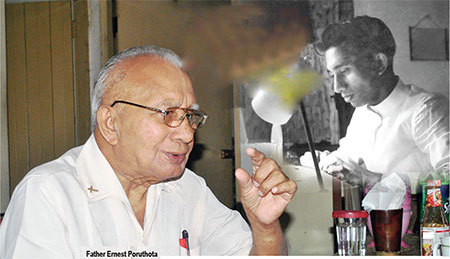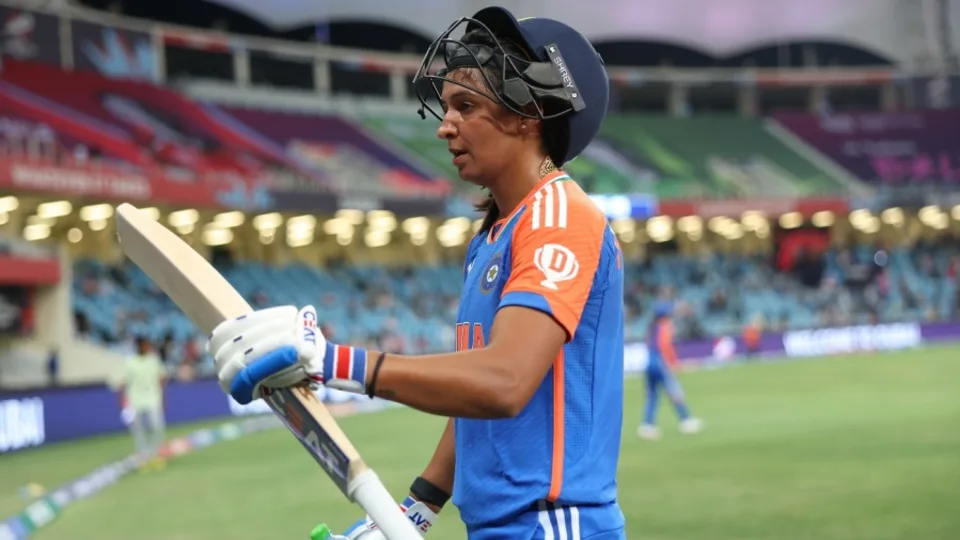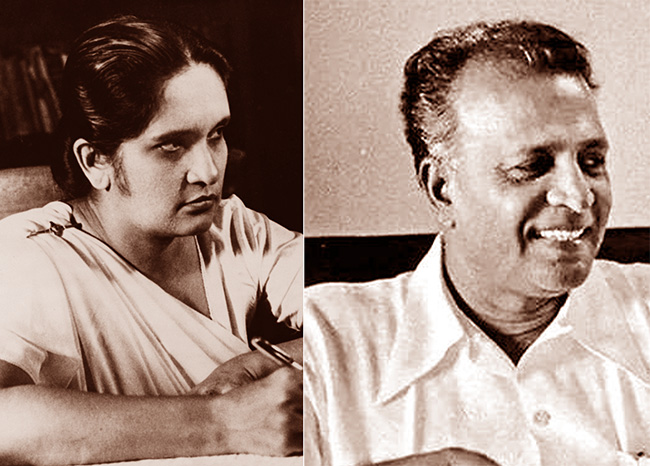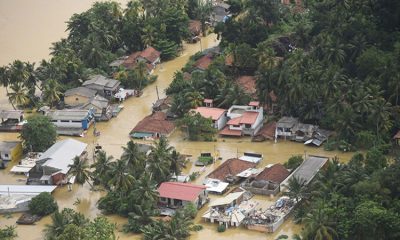Sat Mag
A belated tribute

Father Ernest Poruthota:
By Uditha Devapriya
Prasanna Vithanage remembers the afternoons of his adolescence quite clearly. “I’d take the train to Panadura from Bambalapitiya at 1.57 after school ended, and by 3 I’d be home.” A quick wash and a quick lunch would be followed by a tedious routine: studying, reading, perhaps some play, dinner, sleep. In some ways that came to be my routine also: a quick bath, a quick lunch, and evenings spent hitting the books and indulging in artistic flights of fancy. The only difference was that I didn’t take the train. I took the van.
On Mondays and Fridays, however, Prasanna would change that routine. “I’d spend an hour at home and take the train back to Colombo. By 5.45 I would get down at Fort.” From Fort he walked to a decrepit building in Malwatte Road, where “a group of film enthusiasts screened movies from Britain, the US, France, Germany, Russia, and beyond the Iron Curtain.” They called it Martin Piyathumage Punchi Cinema Hala, and it was officiated, as a church would, by a man of the cloth.
Prasanna made his contact with that man, Ernest Poruthota, at that theatre. It became the first in a long line of encounters, which, as he puts it, “just kept on coming.”
In other words those encounters never ended, and he didn’t have to wait until Monday and Friday for them. “On Poya days Father Poruthota organised discussions on Sinhala films yet to be shown to the public.” At one of these discussions he met H. D. Premaratne; at another he met Dharmasena Pathiraja. Sunil Mihindukula served as the moderator.
From that rendezvous he leapt to another, with a seminar “at Aquinas College where, over three days, we watched three Sinhala films, including Premaratne’s Apeksha and Pathiraja’s Para Dige, and picked up the basics of feature and documentary filmmaking.”
The seminar marked Prasanna’s initiation into films, and it would be followed by another, also organised by Poruthota: “Sri Lanka’s first ever practical film training course”, overseen by Andrew Jayamanne and informally called “the Super 8mm Workshop.” Prasanna made his debut Miniththu, based on a short story by the late Jayalath Manoratne, after the course ended. A decade later he would make his first feature film, Sisila Gini Gani, which like much of his subsequent work revolved around a real incident. He was by then around the same age Dharmasena Pathiraja had been when he’d made his debut, Ahas Gawwa, in 1974; like that landmark classic, Sisila Gini Gani unleashed a new wave in the local cinema, winning practically every award and accolade at every ceremony.
Among those accolades were eight awards at the OCIC Film Festival. There too Prasanna made contact with Father Poruthota; after all, the latter was the first director of the OCIC’s chapter in Sri Lanka. During his tenure he had changed the format of the Festival by turning it into an all category event. The most important such ceremony until then, the Sarasaviya Awards, had been halted after 1971; it wouldn’t be revived until 1980. The OCIC under Poruthota thus filled not only a gap, but also a need.
Meanwhile Prasanna’s encounters with the man continued, long after Sisila Gini Gani, and they proved to be more than coincidental. “An entire generation of directors, including me, Christy Shelton Fernando, and Udayakantha Warnasuriya, emerged from those encounters. In more ways than one, it was all Father Poruthota’s doing.”
The full scope of Poruthota’s contribution can’t really be laid out in a single conversation. Neither Prasanna’s summing up of it, nor Poruthota’s own assessment of it, can do so. And yet an attempt must be made, not least because Poruthota, who died on June 16 at the age of 88, made his contribution to the cinema of this country at a time when the institutions he represented were only just beginning to embrace such secular realms. President Gotabaya Rajapaksa paid tribute to that contribution in his condolence message, where he noted the Father’s “love for the Sinhala language, literature, and our unique identity.”
The man who was to change the way religious authorities looked at the cinema and the arts was very much a product of his time. He was born Raymond Ernest Alexander in 1931 in Marawila, Puttalam. His father, Jokinu Fernando, had worked as a lecturer at the Maggona Teachers’ College. Owing to some disagreements with authorities there, however, he had been dismissed and transferred to Marawila, where he became a head teacher; later, he fell in love with and married a woman from Dambaduraya, Seeduwa. Jokinu also gained a reputation as a publisher of scientific and literary books; among the more popular titles was one on Physical Science, unostentatiously called Kaayika Vidyawa.
Poruthota rebelled against his elders from early on. In an interview I had with him in 2016, he wondered whether he gained his militant streak from his father. “He was a stubborn man. So stubborn, in fact, that when they transferred him he didn’t make a single attempt to appeal it.” Unfortunately for Poruthota though, the old man didn’t take too well to his son taking after him. “I hated going to school. I told my parents I didn’t want to. Obviously they didn’t listen. So every day I’d be dragged from home, along the road, to St Xavier’s College in Marawila, where I obtained my primary education.”
Much of the education he received came from home; in addition to his father’s publishing interests, “he was also a painter of some repute in the locality.” The old man, in fact, stimulated an interest in the decorative arts in him.
By 1940 however, the exasperated parents had realised that, come what may, their headstrong son wasn’t going to finish school. So they decided on the priesthood. “Father and mother came to believe that my vocation lay in the church. With that in mind, in 1942 they admitted me to St Aloysius Seminary in Borella.”
Young Poruthota had his first brush with the cinema at the Borella Seminary, perhaps the unlikeliest of all places where one could see films, given that relations between the Catholic Church and the cinema were, at best, tenuous. Fortunately for Poruthota though, the Rector of the Seminary had an unlikely friend: the Chairman and Managing Director of Ceylon Theatres, Albert Page. “Page had a habit of watching foreign movies, predominantly English movies, at the now defunct Empire Theatre in Colombo before giving the green light for their release. He sent some of them to our Rector and we watched them from time to time.” Forget the usual box office hits though: Poruthota and his friends got to see “only religious parables and epics”, like The Song of Bernadette. Westerns were out of the question, as were screwball comedies and detective thrillers.
 If the cinema came to Poruthota through the Seminary, the Seminary at the same time sustained his interest in the decorative arts. Apparently he and his colleagues had been taken on compulsory walks every Thursday. One such walk, in 1948, had taken them around Torrington Junction, near Independence Square, where they had come across the unveiling of the National Flag at what he recalled as “a rehearsal for the independence ceremony.” Young Poruthota had been awed by the whole thing: “More than the historical significance, what appealed to me were the decorations, the colour, and the liveliness. I was so awed by it that when we returned, I set about replicating the decorations on crepe paper.” I asked him whether this fascination crept up through the artist in him trying to defy the strictures of the Seminary. “Perhaps,” he replied, with a telling smile.
If the cinema came to Poruthota through the Seminary, the Seminary at the same time sustained his interest in the decorative arts. Apparently he and his colleagues had been taken on compulsory walks every Thursday. One such walk, in 1948, had taken them around Torrington Junction, near Independence Square, where they had come across the unveiling of the National Flag at what he recalled as “a rehearsal for the independence ceremony.” Young Poruthota had been awed by the whole thing: “More than the historical significance, what appealed to me were the decorations, the colour, and the liveliness. I was so awed by it that when we returned, I set about replicating the decorations on crepe paper.” I asked him whether this fascination crept up through the artist in him trying to defy the strictures of the Seminary. “Perhaps,” he replied, with a telling smile.
In 1957 Thomas Benjamin Cooray, then Archbishop of Colombo, ordained Poruthota at St Lucia’s Cathedral in Kotahena. Even at that point the attitude of Church authorities to the cinema remained tenuous, if not strained. Two years later, for instance, Roger Vadim’s controversial film And God Created Woman went to the Public Performance Board, which banned it from local theatres. The Catholic Messenger in an editorial on the issue (dated February 1959) hailed the decision, praising the Board over “the high principles formulated by them according to which films must be judged.”
Consider here that the Board was now in the hands of officials appointed by a populist, leftwing government the Church opposed, and you can discern the irony of the congratulatory missive: the Messenger was, in effect, commending an administration it opposed for taking a decision based on religious morals that happened to coincide with their views on the cinema. This becomes even more relevant when we realise the Church departed from such a hostile approach to the arts later on.
The tide began to turn with the Second Vatican Council (1962-1965), at which a key decree, Inter mirifica, urged officials to make use of all forms of social communication, including the cinema. Until then the Church had considered the performing arts as a temporal activity; with the decree, they were anointed a place among spiritual affairs. When the Archbishop returned to Sri Lanka from the Council, he hence took action to enact the letter and spirit of the document. That culminated in the founding of a national office for the OCIC in 1971. In my interview, Father Poruthota told me the OCIC appointed him as director in 1977, but this is an error; according to official accounts, he was appointed in 1972.
Poruthota’s involvement in the theatre predated his work in the cinema. As Sarath Amunugama recalled in an article to The Island, thanks to his friendship with Cyril B. Perera, the ideologue of Sugathapala de Silva’s “Ape Kattiya”, Poruthota allowed the latter troupe to rehearse their plays “in his parish premises.” “Ape Kattiya” staged translations of contemporary Western plays, many of which delved into taboo subjects like homosexuality which the Church frowned upon. And yet, committed as he was to his love for the theatre, Poruthota continued to associate with them. Through them he rekindled his friendship with two other Catholic artists: Tony Ranasinghe and his brother, Ralex.
When he changed the OCIC Awards to an all category ceremony in 1977, Father Poruthota achieved two things. Firstly, he brought in a group of radical critics to the jury, a precedent given that most film juries until then, even at the Sarasaviya Awards, included old civil servants. The 1977 OCIC jury, for instance, had Edwin Ariyadasa, Cyril B. Perera, Professor Chandrasiri Palliyaguru, Ashley Ratnabivushana, Neil I. Perera, Lakshman Welikala, and Ralex Ranasinghe. Secondly, by bringing in these radical critics, he ensured recognition for the emerging left cinema. It’s not a coincidence, after all, that most major winners at the OCIC Awards in this period were articulators of the new cinema; the most coveted and feted among them, of course, being Dharmasena Pathiraja.
That ran into its own share of controversies – in certain years more than one contender had to share the top prize, highlighting the growing rift between the old giants and the new rebels in the industry – but the net result of it was that the OCIC, despite what may have been the resistance of more conservative sections of the Church, gave precedence to a leftwing if not left-of-centre cinematic and cultural discourse. For better or worse, this new wave in the cinema and in film criticism became the doing of the OCIC, and of the man behind the OCIC. It may have not been to everyone’s liking, yet that is what it was and that is what it eventually became.
Where do all these reflections leave Father Poruthota? He didn’t want to be a divisive figure, and in the end, despite his outspokenness, or rather because of it – in particular, his opposition to censorship “of any form” – he prevailed. This wasn’t limited to the cinema of course, though we can contend that it was where his biggest contribution lay; as Prasanna Vithanage put it, “he brought so many newcomers to the industry.” Vithanage, in fact, compared what he did to the opening of a door: “Church fathers, from their pulpits, appeal to the gatekeepers of heaven to let us in. I feel Father Poruthota opened many doors and windows for budding filmmakers like me to enter, right here on earth.”
The writer can be reached at udakdev1@gmail.com
Sat Mag
October 13 at the Women’s T20 World Cup: Injury concerns for Australia ahead of blockbuster game vs India

Australia vs India
Sharjah, 6pm local time
Australia have major injury concerns heading into the crucial clash. Just four balls into the match against Pakistan, Tayla Vlaeminck was out with a right shoulder dislocation. To make things worse, captain Alyssa Healy suffered an acute right foot injury while batting on 37 as she hobbled off the field with Australia needing 14 runs to win. Both players went for scans on Saturday.
India captain Harmanpreet Kaur who had hurt her neck in the match against Pakistan, turned up with a pain-relief patch on the right side of her neck during the Sri Lanka match. She also didn’t take the field during the chase. Fast bowler Pooja Vastrakar bowled full-tilt before the Sri Lanka game but didn’t play.
India will want a big win against Australia. If they win by more than 61 runs, they will move ahead of Australia, thereby automatically qualifying for the semi-final. In a case where India win by fewer than 60 runs, they will hope New Zealand win by a very small margin against Pakistan on Monday. For instance, if India make 150 against Australia and win by exactly 10 runs, New Zealand need to beat Pakistan by 28 runs defending 150 to go ahead of India’s NRR. If India lose to Australia by more than 17 runs while chasing a target of 151, then New Zealand’s NRR will be ahead of India, even if Pakistan beat New Zealand by just 1 run while defending 150.
Overall, India have won just eight out of 34 T20Is they’ve played against Australia. Two of those wins came in the group-stage games of previous T20 World Cups, in 2018 and 2020.
Australia squad:
Alyssa Healy (capt & wk), Darcie Brown, Ashleigh Gardner, Kim Garth, Grace Harris, Alana King, Phoebe Litchfield, Tahlia McGrath, Sophie Molineux, Beth Mooney, Ellyse Perry, Megan Schutt, Annabel Sutherland, Tayla Vlaeminck, Georgia Wareham
India squad:
Harmanpreet Kaur (capt), Smriti Mandhana (vice-capt), Yastika Bhatia (wk), Shafali Verma, Deepti Sharma, Jemimah Rodrigues, Richa Ghosh (wk), Pooja Vastrakar, Arundhati Reddy, Renuka Singh, D Hemalatha, Asha Sobhana, Radha Yadav, Shreyanka Patil, S Sajana
Tournament form guide:
Australia have three wins in three matches and are coming into this contest having comprehensively beaten Pakistan. With that win, they also all but sealed a semi-final spot thanks to their net run rate of 2.786. India have two wins in three games. In their previous match, they posted the highest total of the tournament so far – 172 for 3 and in return bundled Sri Lanka out for 90 to post their biggest win by runs at the T20 World Cup.
Players to watch:
Two of their best batters finding their form bodes well for India heading into the big game. Harmanpreet and Mandhana’s collaborative effort against Pakistan boosted India’s NRR with the semi-final race heating up. Mandhana, after a cautious start to her innings, changed gears and took on Sri Lanka’s spinners to make 50 off 38 balls. Harmanpreet, continuing from where she’d left against Pakistan, played a classic, hitting eight fours and a six on her way to a 27-ball 52. It was just what India needed to reinvigorate their T20 World Cup campaign.
[Cricinfo]
Sat Mag
Living building challenge

By Eng. Thushara Dissanayake
The primitive man lived in caves to get shelter from the weather. With the progression of human civilization, people wanted more sophisticated buildings to fulfill many other needs and were able to accomplish them with the help of advanced technologies. Security, privacy, storage, and living with comfort are the common requirements people expect today from residential buildings. In addition, different types of buildings are designed and constructed as public, commercial, industrial, and even cultural or religious with many advanced features and facilities to suit different requirements.
We are facing many environmental challenges today. The most severe of those is global warming which results in many negative impacts, like floods, droughts, strong winds, heatwaves, and sea level rise due to the melting of glaciers. We are experiencing many of those in addition to some local issues like environmental pollution. According to estimates buildings account for nearly 40% of all greenhouse gas emissions. In light of these issues, we have two options; we change or wait till the change comes to us. Waiting till the change come to us means that we do not care about our environment and as a result we would have to face disastrous consequences. Then how can we change in terms of building construction?
Before the green concept and green building practices come into play majority of buildings in Sri Lanka were designed and constructed just focusing on their intended functional requirements. Hence, it was much likely that the whole process of design, construction, and operation could have gone against nature unless done following specific regulations that would minimize negative environmental effects.
We can no longer proceed with the way we design our buildings which consumes a huge amount of material and non-renewable energy. We are very concerned about the food we eat and the things we consume. But we are not worrying about what is a building made of. If buildings are to become a part of our environment we have to design, build and operate them based on the same principles that govern the natural world. Eventually, it is not about the existence of the buildings, it is about us. In other words, our buildings should be a part of our natural environment.
The living building challenge is a remarkable design philosophy developed by American architect Jason F. McLennan the founder of the International Living Future Institute (ILFI). The International Living Future Institute is an environmental NGO committed to catalyzing the transformation toward communities that are socially just, culturally rich, and ecologically restorative. Accordingly, a living building must meet seven strict requirements, rather certifications, which are called the seven “petals” of the living building. They are Place, Water, Energy, Equity, Materials, Beauty, and Health & Happiness. Presently there are about 390 projects around the world that are being implemented according to Living Building certification guidelines. Let us see what these seven petals are.
Place
This is mainly about using the location wisely. Ample space is allocated to grow food. The location is easily accessible for pedestrians and those who use bicycles. The building maintains a healthy relationship with nature. The objective is to move away from commercial developments to eco-friendly developments where people can interact with nature.
Water
It is recommended to use potable water wisely, and manage stormwater and drainage. Hence, all the water needs are captured from precipitation or within the same system, where grey and black waters are purified on-site and reused.
Energy
Living buildings are energy efficient and produce renewable energy. They operate in a pollution-free manner without carbon emissions. They rely only on solar energy or any other renewable energy and hence there will be no energy bills.
Equity
What if a building can adhere to social values like equity and inclusiveness benefiting a wider community? Yes indeed, living buildings serve that end as well. The property blocks neither fresh air nor sunlight to other adjacent properties. In addition, the building does not block any natural water path and emits nothing harmful to its neighbors. On the human scale, the equity petal recognizes that developments should foster an equitable community regardless of an individual’s background, age, class, race, gender, or sexual orientation.
Materials
Materials are used without harming their sustainability. They are non-toxic and waste is minimized during the construction process. The hazardous materials traditionally used in building components like asbestos, PVC, cadmium, lead, mercury, and many others are avoided. In general, the living buildings will not consist of materials that could negatively impact human or ecological health.
Beauty
Our physical environments are not that friendly to us and sometimes seem to be inhumane. In contrast, a living building is biophilic (inspired by nature) with aesthetical designs that beautify the surrounding neighborhood. The beauty of nature is used to motivate people to protect and care for our environment by connecting people and nature.
Health & Happiness
The building has a good indoor and outdoor connection. It promotes the occupants’ physical and psychological health while causing no harm to the health issues of its neighbors. It consists of inviting stairways and is equipped with operable windows that provide ample natural daylight and ventilation. Indoor air quality is maintained at a satisfactory level and kitchen, bathrooms, and janitorial areas are provided with exhaust systems. Further, mechanisms placed in entrances prevent any materials carried inside from shoes.
The Bullitt Center building
Bullitt Center located in the middle of Seattle in the USA, is renowned as the world’s greenest commercial building and the first office building to earn Living Building certification. It is a six-story building with an area of 50,000 square feet. The area existed as a forest before the city was built. Hence, the Bullitt Center building has been designed to mimic the functions of a forest.
The energy needs of the building are purely powered by the solar system on the rooftop. Even though Seattle is relatively a cloudy city the Bullitt Center has been able to produce more energy than it needed becoming one of the “net positive” solar energy buildings in the world. The important point is that if a building is energy efficient only the area of the roof is sufficient to generate solar power to meet its energy requirement.
It is equipped with an automated window system that is able to control the inside temperature according to external weather conditions. In addition, a geothermal heat exchange system is available as the source of heating and cooling for the building. Heat pumps convey heat stored in the ground to warm the building in the winter. Similarly, heat from the building is conveyed into the ground during the summer.
The potable water needs of the building are achieved by treating rainwater. The grey water produced from the building is treated and re-used to feed rooftop gardens on the third floor. The black water doesn’t need a sewer connection as it is treated to a desirable level and sent to a nearby wetland while human biosolid is diverted to a composting system. Further, nearly two third of the rainwater collected from the roof is fed into the groundwater and the process resembles the hydrologic function of a forest.
It is encouraging to see that most of our large-scale buildings are designed and constructed incorporating green building concepts, which are mainly based on environmental sustainability. The living building challenge can be considered an extension of the green building concept. Amanda Sturgeon, the former CEO of the ILFI, has this to say in this regard. “Before we start a project trying to cram in every sustainable solution, why not take a step outside and just ask the question; what would nature do”?
Sat Mag
Something of a revolution: The LSSP’s “Great Betrayal” in retrospect

By Uditha Devapriya
On June 7, 1964, the Central Committee of the Lanka Sama Samaja Party convened a special conference at which three resolutions were presented. The first, moved by N. M. Perera, called for a coalition with the SLFP, inclusive of any ministerial portfolios. The second, led by the likes of Colvin R. de Silva, Leslie Goonewardena, and Bernard Soysa, advocated a line of critical support for the SLFP, but without entering into a coalition. The third, supported by the likes of Edmund Samarakkody and Bala Tampoe, rejected any form of compromise with the SLFP and argued that the LSSP should remain an independent party.
The conference was held a year after three parties – the LSSP, the Communist Party, and Philip Gunawardena’s Mahajana Eksath Peramuna – had founded a United Left Front. The ULF’s formation came in the wake of a spate of strikes against the Sirimavo Bandaranaike government. The previous year, the Ceylon Transport Board had waged a 17-day strike, and the harbour unions a 60-day strike. In 1963 a group of working-class organisations, calling itself the Joint Committee of Trade Unions, began mobilising itself. It soon came up with a common programme, and presented a list of 21 radical demands.
In response to these demands, Bandaranaike eventually supported a coalition arrangement with the left. In this she was opposed, not merely by the right-wing of her party, led by C. P. de Silva, but also those in left parties opposed to such an agreement, including Bala Tampoe and Edmund Samarakkody. Until then these parties had never seen the SLFP as a force to reckon with: Leslie Goonewardena, for instance, had characterised it as “a Centre Party with a programme of moderate reforms”, while Colvin R. de Silva had described it as “capitalist”, no different to the UNP and by default as bourgeois as the latter.
The LSSP’s decision to partner with the government had a great deal to do with its changing opinions about the SLFP. This, in turn, was influenced by developments abroad. In 1944, the Fourth International, which the LSSP had affiliated itself with in 1940 following its split with the Stalinist faction, appointed Michel Pablo as its International Secretary. After the end of the war, Pablo oversaw a shift in the Fourth International’s attitude to the Soviet states in Eastern Europe. More controversially, he began advocating a strategy of cooperation with mass organisations, regardless of their working-class or radical credentials.
Pablo argued that from an objective perspective, tensions between the US and the Soviet Union would lead to a “global civil war”, in which the Soviet Union would serve as a midwife for world socialist revolution. In such a situation the Fourth International would have to take sides. Here he advocated a strategy of entryism vis-à-vis Stalinist parties: since the conflict was between Stalinist and capitalist regimes, he reasoned, it made sense to see the former as allies. Such a strategy would, in his opinion, lead to “integration” into a mass movement, enabling the latter to rise to the level of a revolutionary movement.

Though controversial, Pablo’s line is best seen in the context of his times. The resurgence of capitalism after the war, and the boom in commodity prices, had a profound impact on the course of socialist politics in the Third World. The stunted nature of the bourgeoisie in these societies had forced left parties to look for alternatives. For a while, Trotsky had been their guide: in colonial and semi-colonial societies, he had noted, only the working class could be expected to see through a revolution. This entailed the establishment of workers’ states, but only those arising from a proletarian revolution: a proposition which, logically, excluded any compromise with non-radical “alternatives” to the bourgeoisie.
To be sure, the Pabloites did not waver in their support for workers’ states. However, they questioned whether such states could arise only from a proletarian revolution. For obvious reasons, their reasoning had great relevance for Trotskyite parties in the Third World. The LSSP’s response to them showed this well: while rejecting any alliance with Stalinist parties, the LSSP sympathised with the Pabloites’ advocacy of entryism, which involved a strategic orientation towards “reformist politics.” For the world’s oldest Trotskyite party, then going through a series of convulsions, ruptures, and splits, the prospect of entering the reformist path without abandoning its radical roots proved to be welcoming.
Writing in the left-wing journal Community in 1962, Hector Abhayavardhana noted some of the key concerns that the party had tried to resolve upon its formation. Abhayavardhana traced the LSSP’s origins to three developments: international communism, the freedom struggle in India, and local imperatives. The latter had dictated the LSSP’s manifesto in 1936, which included such demands as free school books and the use of Sinhala and Tamil in the law courts. Abhayavardhana suggested, correctly, that once these imperatives changed, so would the party’s focus, though within a revolutionary framework. These changes would be contingent on two important factors: the establishment of universal franchise in 1931, and the transfer of power to the local bourgeoisie in 1948.
Paradoxical as it may seem, the LSSP had entered the arena of radical politics through the ballot box. While leading the struggle outside parliament, it waged a struggle inside it also. This dual strategy collapsed when the colonial government proscribed the party and the D. S. Senanayake government disenfranchised plantation Tamils. Suffering two defeats in a row, the LSSP was forced to think of alternatives. That meant rethinking categories such as class, and grounding them in the concrete realities of the country.
This was more or less informed by the irrelevance of classical and orthodox Marxian analysis to the situation in Sri Lanka, specifically to its rural society: with a “vast amorphous mass of village inhabitants”, Abhayavardhana observed, there was no real basis in the country for a struggle “between rich owners and the rural poor.” To complicate matters further, reforms like the franchise and free education, which had aimed at the emancipation of the poor, had in fact driven them away from “revolutionary inclinations.” The result was the flowering of a powerful rural middle-class, which the LSSP, to its discomfort, found it could not mobilise as much as it had the urban workers and plantation Tamils.
Where else could the left turn to? The obvious answer was the rural peasantry. But the rural peasantry was in itself incapable of revolution, as Hector Abhayavardhana has noted only too clearly. While opposing the UNP’s Westernised veneer, it did not necessarily oppose the UNP’s overtures to Sinhalese nationalism. As historians like K. M. de Silva have observed, the leaders of the UNP did not see their Westernised ethos as an impediment to obtaining support from the rural masses. That, in part at least, was what motivated the Senanayake government to deprive Indian estate workers of their most fundamental rights, despite the existence of pro-minority legal safeguards in the Soulbury Constitution.
To say this is not to overlook the unique character of the Sri Lankan rural peasantry and petty bourgeoisie. Orthodox Marxists, not unjustifiably, characterise the latter as socially and politically conservative, tilting more often than not to the right. In Sri Lanka, this has frequently been the case: they voted for the UNP in 1948 and 1952, and voted en masse against the SLFP in 1977. Yet during these years they also tilted to the left, if not the centre-left: it was the petty bourgeoisie, after all, which rallied around the SLFP, and supported its more important reforms, such as the nationalisation of transport services.
One must, of course, be wary of pasting the radical tag on these measures and the classes that ostensibly stood for them. But if the Trotskyite critique of the bourgeoisie – that they were incapable of reform, even less revolution – holds valid, which it does, then the left in the former colonies of the Third World had no alternative but to look elsewhere and to be, as Abhayavardhana noted, “practical men” with regard to electoral politics. The limits within which they had to work in Sri Lanka meant that, in the face of changing dynamics, especially among the country’s middle-classes, they had to change their tactics too.
Meanwhile, in 1953, the Trotskyite critique of Pabloism culminated with the publication of an Open Letter by James Cannon, of the US Socialist Workers’ Party. Cannon criticised the Pabloite line, arguing that it advocated a policy of “complete submission.” The publication of the letter led to the withdrawal of the International Committee of the Fourth International from the International Secretariat. The latter, led by Pablo, continued to influence socialist parties in the Third World, advocating temporary alliances with petty bourgeois and centrist formations in the guise of opposing capitalist governments.
For the LSSP, this was a much-needed opening. Even as late as 1954, three years after S. W. R. D. Bandaranaike formed the SLFP, the LSSP continued to characterise the latter as the alternative bourgeois party in Ceylon. Yet this did not deter it from striking up no contest pacts with Bandaranaike at the 1956 election, a strategy that went back to November 1951, when the party requested the SLFP to hold a discussion about the possibility of eliminating contests in the following year’s elections. Though it extended critical support to the MEP government in 1956, the LSSP opposed the latter once it enacted emergency measures in 1957, mobilising trade union action for a period of three years.
At the 1960 election the LSSP contested separately, with the slogan “N. M. for P.M.” Though Sinhala nationalism no longer held sway as it had in 1956, the LSSP found itself reduced to a paltry 10 seats. It was against this backdrop that it began rethinking its strategy vis-à-vis the ruling party. At the throne speech in April 1960, Perera openly declared that his party would not stabilise the SLFP. But a month later, in May, he called a special conference, where he moved a resolution for a coalition with the party. As T. Perera has noted in his biography of Edmund Samarakkody, the response to the resolution unearthed two tendencies within the oppositionist camp: the “hardliners” who opposed any compromise with the SLFP, including Samarakkody, and the “waverers”, including Leslie Goonewardena.
These tendencies expressed themselves more clearly at the 1964 conference. While the first resolution by Perera called for a complete coalition, inclusive of Ministries, and the second rejected a coalition while extending critical support, the third rejected both tactics. The outcome of the conference showed which way these tendencies had blown since they first manifested four years earlier: Perera’s resolution obtained more than 500 votes, the second 75 votes, the third 25. What the anti-coalitionists saw as the “Great Betrayal” of the LSSP began here: in a volte-face from its earlier position, the LSSP now held the SLFP as a party of a radical petty bourgeoisie, capable of reform.
History has not been kind to the LSSP’s decision. From 1970 to 1977, a period of less than a decade, these strategies enabled it, as well as the Communist Party, to obtain a number of Ministries, as partners of a petty bourgeois establishment. This arrangement collapsed the moment the SLFP turned to the right and expelled the left from its ranks in 1975, in a move which culminated with the SLFP’s own dissolution two years later.
As the likes of Samarakkody and Meryl Fernando have noted, the SLFP needed the LSSP and Communist Party, rather than the other way around. In the face of mass protests and strikes in 1962, the SLFP had been on the verge of complete collapse. The anti-coalitionists in the LSSP, having established themselves as the LSSP-R, contended later on that the LSSP could have made use of this opportunity to topple the government.
Whether or not the LSSP could have done this, one can’t really tell. However, regardless of what the LSSP chose to do, it must be pointed out that these decades saw the formation of several regimes in the Third World which posed as alternatives to Stalinism and capitalism. Moreover, the LSSP’s decision enabled it to see through certain important reforms. These included Workers’ Councils. Critics of these measures can point out, as they have, that they could have been implemented by any other regime. But they weren’t. And therein lies the rub: for all its failings, and for a brief period at least, the LSSP-CP-SLFP coalition which won elections in 1970 saw through something of a revolution in the country.
The writer is an international relations analyst, researcher, and columnist based in Sri Lanka who can be reached at udakdev1@gmail.com
-

 News5 days ago
News5 days agoWeather disasters: Sri Lanka flooded by policy blunders, weak enforcement and environmental crime – Climate Expert
-

 Latest News6 days ago
Latest News6 days agoLevel I landslide RED warnings issued to the districts of Badulla, Colombo, Gampaha, Kalutara, Kandy, Kegalle, Kurnegala, Natale, Monaragala, Nuwara Eliya and Ratnapura
-

 Latest News6 days ago
Latest News6 days agoINS VIKRANT deploys helicopters for disaster relief operations
-
News2 days ago
Lunuwila tragedy not caused by those videoing Bell 212: SLAF
-

 Latest News6 days ago
Latest News6 days agoDepartment of Irrigation issues Critical flood warning to the Kelani river basin
-

 Latest News3 days ago
Latest News3 days agoLevel III landslide early warnings issued to the districts of Badulla, Kandy, Kegalle, Kurunegala, Matale and Nuwara-Eliya
-

 News6 days ago
News6 days agoCountry reels under worst weather in living memory
-

 Editorial6 days ago
Editorial6 days agoNeeded: Action not rhetoric













